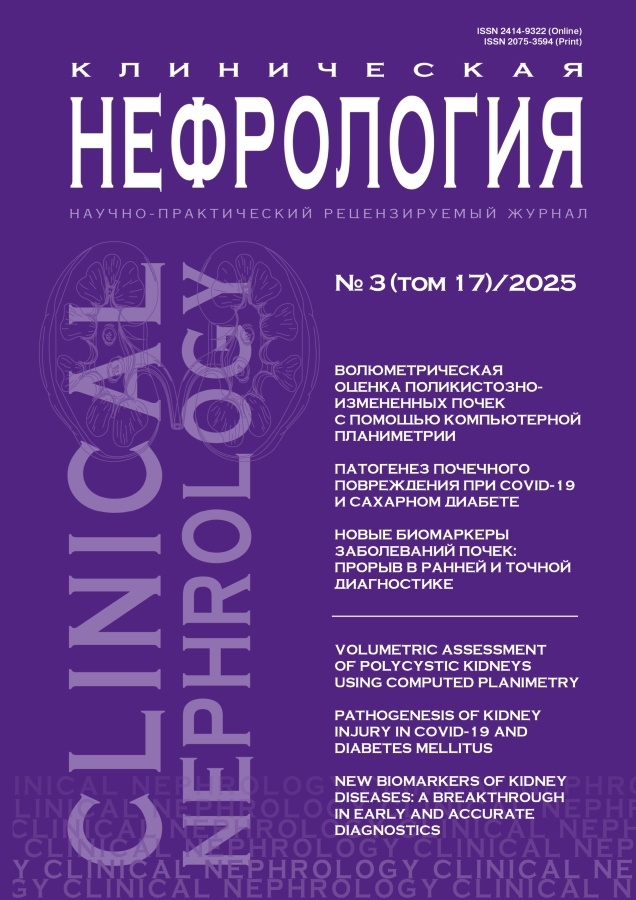Clinical and epidemiological data on catheter-associated bloodstream infections among patients undergoing hemodialysis treatment
- Authors: Mirazimova I.S.1, Karunnaya A.V.1, Yesayan A.M.1
-
Affiliations:
- First Pavlov State Medical University of St. Petersburg
- Issue: Vol 17, No 3 (2025)
- Pages: 76-80
- Section: Literature Reviews
- Published: 10.10.2025
- URL: https://journals.eco-vector.com/2075-3594/article/view/692785
- DOI: https://doi.org/10.18565/nephrology.2025.3.76-80
- ID: 692785
Cite item
Abstract
This literature review analyzes data on the prevalence of catheter-associated bloodstream infection (CABI) in patients receiving renal replacement therapy by hemodialysis. Key epidemiological indicators, including the incidence of CABI, the spectrum of main pathogens and risk factors are considered in detail. Current data on complex preventive measures, including the use of antimicrobial solutions for closing the catheter, antiseptic barrier caps, are presented. The effectiveness of transparent adhesive dressings with chlorhexidine gluconate, local antiseptic and antibacterial ointments is discussed. The importance of early detection of infection and timely administration of empirical antimicrobial therapy is emphasized.
Full Text
About the authors
Irina S. Mirazimova
First Pavlov State Medical University of St. Petersburg
Author for correspondence.
Email: irinamirazimova@mail.ru
ORCID iD: 0009-0001-0719-7569
Nephrologist, Chronic Hemodialysis Department
Russian Federation, Saint PetersburgAnna V. Karunnaya
First Pavlov State Medical University of St. Petersburg
Email: a.v.karunnaya@yandex.ru
ORCID iD: 0000-0003-0758-8137
Nephrologist, Head of the Chronic Hemodialysis Department, Teaching Assistant, Nephrology and Dialysis Department
Russian Federation, Saint PetersburgAshot M. Yesayan
First Pavlov State Medical University of St. Petersburg
Email: essaian.ashot@gmail.com
ORCID iD: 0000-0002-7202-3151
Dr.Sci. (Med.), Professor, Head of the Department of Nephrology and Dialysis, Chief Nephrologist of the North-Western Federal District of the Russian Federation
Russian Federation, Saint PetersburgReferences
- Maki D.G., Kluger D.M., Crnich C.J. The risk of bloodstream infection in adults with different intravascular devices: a systematic review of 200 published prospective studies. Mayo Clin. Proc. 2006;81(9):1159–71. doi: 10.4065/81.9.1159.
- Профилактика катетер-ассоциированных инфекций кровотока и уход за центральным венозным катетерам: национальные клинические рекомендации. 2017. [Prevention of catheter-associated bloodstream infections and care of central venous catheters: national clinical guidelines. 2017 (In Russ.)].
- Zarb P., Coignard B., Griskeviciene J. et al. National Contact Points for the ECDC pilot point prevalence survey; Hospital Contact Points for the ECDC pilot point prevalence survey. The European Centre for Disease Prevention and Control (ECDC) pilot point prevalence survey of healthcare-associated infections and antimicrobial use. Euro Surveill. 2012;17(46):20316. doi: 10.2807/ese.17.46.20316-en.
- Fisher M., Golestaneh L., Allon M. et al. Prevention of Bloodstream Infections in Patients Undergoing Hemodialysis. Clin. J. Am. Soc. Nephrol. 2020;15(1):132–51. doi: 10.2215/CJN.06820619. [Epub 2019 Dec 5. Erratum in: Clin J Am Soc Nephrol. 2022;17(4):568-569]. doi: 10.2215/CJN.01840222.
- Grothe C., Taminato M., Belasco A., et al. Screening and treatment for Staphylococcus aureus in patients undergoing hemodialysis: a systematic review and meta-analysis. BMC. Nephrol. 2014;15:202. doi: 10.1186/1471-2369-15-202.
- Gebreselassie H.M., Lo Priore E., Marschall J. Effectiveness of meticillin-resistant Staphylococcus aureus decolonization in long-term haemodialysis patients: a systematic review and meta-analysis. J. Hosp. Infect. 2015;91(3):250–6. doi: 10.1016/j.jhin.2015.08.015.
- Квашнина Д.В., Ковалишена О.В., Белянина Н.А. Комплексная клинико-этиологическая и эпидемиологическая характеристика катетер-ассоциированных инфекций кровотока. Мед. альманах. 2017;4(49):41–5. [Kvashnina D.V., Kovalishena O.V., Belyanina N.A. Complex clinical, etiological and epidemiological characteristics of catheter-associated bloodstream infections. Med. Almanac. 2017;4(49):41–5 (In Russ.)].
- Weldetensae M.K., Weledegebriel M.G., Nigusse A.T. et al. Catheter-Related Blood Stream Infections and Associated Factors Among Hemodialysis Patients in a Tertiary Care Hospital. Infect. Drug Resist. 2023;16:3145–56. doi: 10.2147/IDR.S409400.
- Hymes J.L., Mooney A., Van Zandt C. et al. Dialysis Catheter-Related Bloodstream Infections: A Cluster-Randomized Trial of the ClearGuard HD Antimicrobial Barrier Cap. Am. J. Kidney Dis. 2017;69(2):220–7. doi: 10.1053/j.ajkd.2016.09.014.
- Lok C.E., Huber T.S., Lee T. et al. KDOQI Clinical Practice Guideline for Vascular Access: 2019 Update. Am. J. Kidney Dis. 2020;75(4 Suppl. 2):1–164. doi: 10.1053/j.ajkd.2019.12.001. [Epub 2020 Mar 12. Erratum in: Am J Kidney Dis. 2021;77(4):551. doi: 10.1053/j.ajkd.2021.02.002].
- Haq A., Patel D., Gutlapalli S.D. et al. Systematic Review of the Impact of Antibiotic and Antimicrobial Catheter Locks on Catheter-Related Infections in Adult Patients Receiving Hemodialysis. Cureus. 2023;15(9):e45000. doi: 10.7759/cureus.45000.
- Surveillance Summary of Bloodstream Infections (BSI) in Outpatient Hemodialysis Facilities – National Healthcare Safety Network, 2014–2019.
- Protocol for the surveillance of healthcare-associated infections and prevention indicators in European intensive care unit; 2024. https://www.ecdc.europa.eu/sites/default/files/documents/protocol-surveillance-healthcare-associated-infections-intensive-care.pdf.
- Bloodstream Infection Event (Central Line-Associated Bloodstream Infection and Non-central Line Associated Bloodstream Infection); 2025. https://www.cdc.gov/nhsn/pdfs/pscmanual/4psc_clabscurrent.pdf.
- Antimicrobial Resistance Collaborators. Global burden of bacterial antimicrobial resistance in 2019: a systematic analysis. Lancet. 2022;399(10325):629–55. doi: 10.1016/S0140-6736(21)02724-0.
- World Health Organization. Global report on infection prevention and control. Geneva: WHO; 2022. https://www.who.int/publications/i/item/9789240051164.
- Vanholder R., Canaud B., Fluck R. et al. Diagnosis, prevention and treatment of haemodialysis catheter-related bloodstream infections (CRBSI): a position statement of European Renal Best Practice (ERBP). NDT. Plus. 2010;3(3):234–46. doi: 10.1093/ndtplus/sfq041.
- Ullman A.J., Cooke M.L., Mitchell M. et al. Dressings and securement devices for central venous catheters (CVC). Cochrane Database Syst. Rev. 2015;2015(9):CD010367. doi: 10.1002/14651858.CD010367. pub2.
- Solomon L.R., Cheesbrough J.S., Bhargava R. et al. Observational study of need for thrombolytic therapy and incidence of bacteremia using taurolidine-citrate-heparin, taurolidine-citrate and heparin catheter locks in patients treated with hemodialysis. Semin. Dial. 2012;25(2):233–8. doi: 10.1111/j.1525-139X.2011.00951.x.
- Agarwal A.K., Roy-Chaudhury P., Mounts P. et al. Taurolidine/Heparin Lock Solution and Catheter-Related Bloodstream Infection in Hemodialysis: A Randomized, Double-Blind, Active-Control, Phase 3 Study. Clin. J. Am. Soc. Nephrol. 2023;18(11):1446–55. doi: 10.2215/CJN.0000000000000278.
Supplementary files








